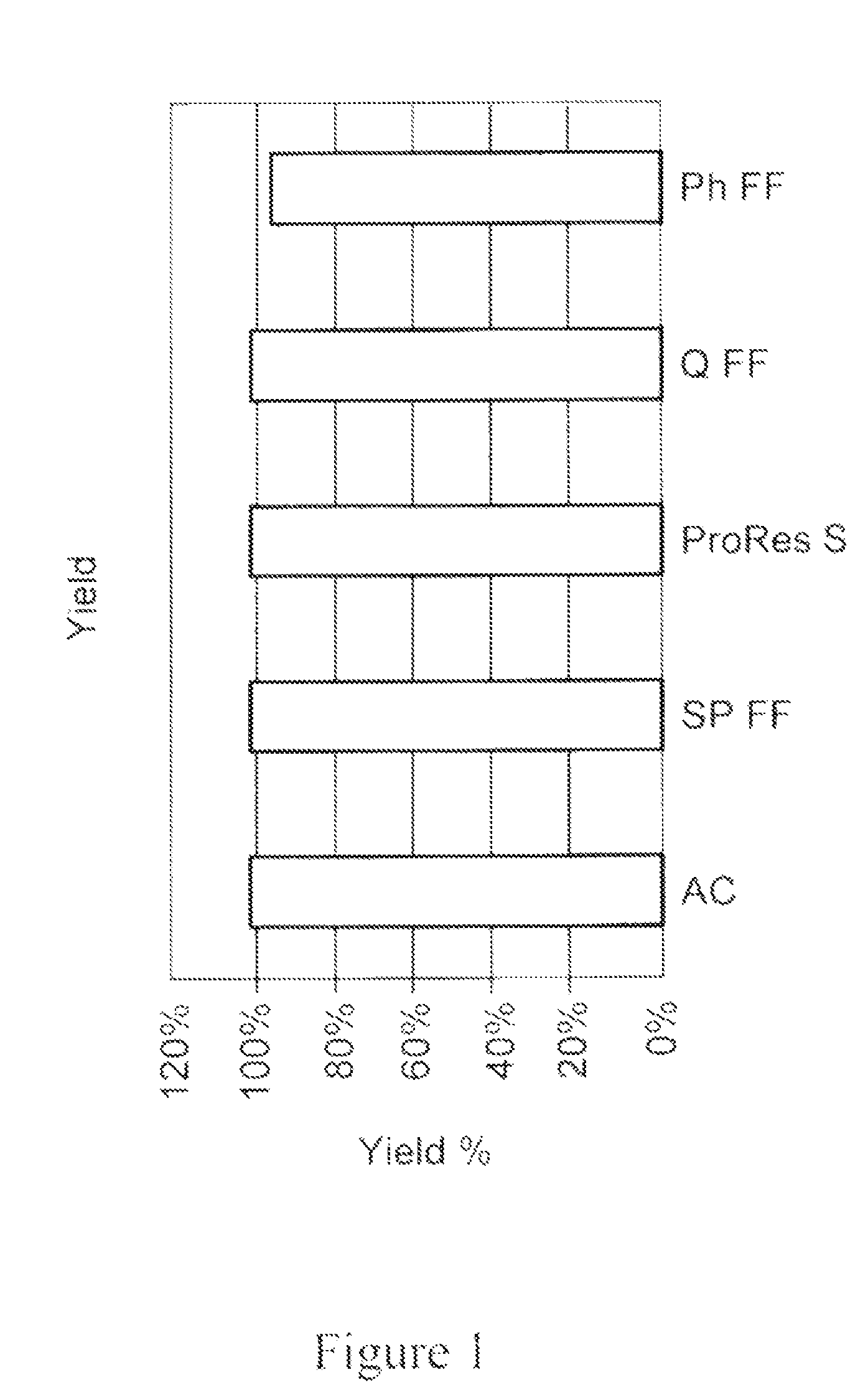Methods of reducing level of one or more impurities in a sample during protein purification
a technology of chromatography and impurities, applied in the field of improved chromatography methods and methods of reducing the level of one or more impurities during protein purification, can solve the problems of increasing the burden of fairly expensive chromatography media, user having to dispose of columns, and labor and time-consuming chromatography columns, so as to reduce the burden of chromatography columns and increase the life of chromatography columns.
- Summary
- Abstract
- Description
- Claims
- Application Information
AI Technical Summary
Benefits of technology
Problems solved by technology
Method used
Image
Examples
example 1
Evaluation of Various Materials for Impurity Removal in Flow-Through Mode
[0159]In this experiment, different materials were evaluated for their ability to remove impurities from a clarified CHO feed. Materials, shown in Table II, were tested for impurity removal in flow-through mode. Phosphate buffer saline (PBS, 10 mM phosphate, pH 7.4) was used as an equilibrium and wash buffer.
[0160]
TABLE IIMaterialAcronymDescriptionVendor / CatalogActivatedACRGC 80MeadWestVadocarbonSP sepharoseSP FFAgarose cation exchangeGE HealthcareFastflowchromatography (CIEX)resinProRes ™-SProRes ™-SPolymeric cationMilliporeexchangeCorporationchromatography (CIEX)resinQ sepharoseQ FFAgarose anion exchangeGE HealthcareFastFlowchromatography (AIEX)resinPhenylPh FFAgarose hydrophobicGE HealthcareSepharoseinteractionFastFlowchromatography (HIC)resin
[0161]Gravity flow-through (FT) test method was used to test resin impurity removal. One ml of each material listed in Table II (1 ml) was allowed to settle and packed ...
example 2
Flow-Through Impurity Removal Capacity
[0166]In a representative experiment, the amount of impurities removed by different materials per unit volume was evaluated. The level of DNA in the CHO-S feed was increased through the addition of commercially available Herring Sperm DNA to understand the effect of adsorption competition between DNA and HCP. The materials that were evaluated for impurity removal are listed in Table III below.
[0167]
TABLE IIIMaterialAcronymDescriptionVendor / CatlogActivatedACactivated carbonMeadWestVacocarbonRGC 80SP sepharoseSP FFcation exchangeGE Healthcare,FastFlowchromatography (CIEX)Cat# 17-0729-01resin, agarose basematrixProRes ™-SProRes ™-Scation exchangeMilliporechromatography (CIEX)Corporationresin, polymeric basematrixQ sepharoseQ FFAnion exchangeGE Healthcare,FastFlowchromatography (AIEX)Cat# 17-0510-01resin, agarose basematrix
[0168]Each of the materials listed in Table III (1 ml) were packed into an Omnifit column (0.66 cm i.d.). Columns were equilibra...
example 3
Effect of Combinations of Different Materials on Impurity Removal
[0171]In another experiment, different combinations of materials, shown in the work flow depicted in FIG. 9, were evaluated for impurity removal. The materials (1 ml) were allowed to settle and packed into a 5 ml disposable chromatography column. Columns were equilibrated with 5 CVs of PBS, loaded with 20 CVs feed and washed with 5 CVs of PBS.
[0172]The flow-through eluant fraction was further loaded on o the next disposable column of the selected media (as shown in the two workflows depicted on the left in FIG. 9). The last flow-through eluant in the work flow was analyzed. In case of the work flow depicted on the right, in which a feed went through a mixture of media, the eluant was analyzed directly. Feed was prepared using non-expressing CHO-S feed with addition of polyclonal IgG (˜2.5 mg / ml) from SeraCare. Flow-through eluant fractions and the corresponding feeds were assayed for IgG yield. UV active species, HCP a...
PUM
| Property | Measurement | Unit |
|---|---|---|
| diameter | aaaaa | aaaaa |
| molecular weight | aaaaa | aaaaa |
| molecular weight | aaaaa | aaaaa |
Abstract
Description
Claims
Application Information
 Login to View More
Login to View More - R&D
- Intellectual Property
- Life Sciences
- Materials
- Tech Scout
- Unparalleled Data Quality
- Higher Quality Content
- 60% Fewer Hallucinations
Browse by: Latest US Patents, China's latest patents, Technical Efficacy Thesaurus, Application Domain, Technology Topic, Popular Technical Reports.
© 2025 PatSnap. All rights reserved.Legal|Privacy policy|Modern Slavery Act Transparency Statement|Sitemap|About US| Contact US: help@patsnap.com



